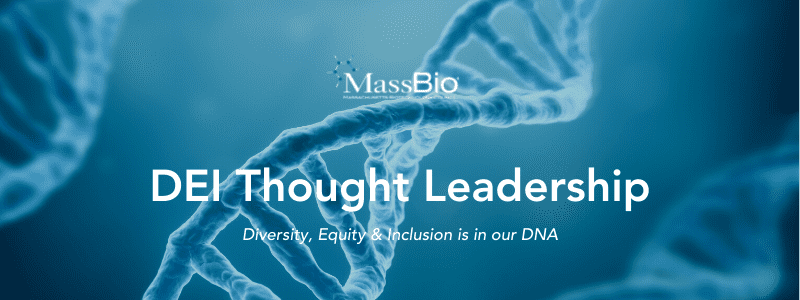
In the past two years, two major events have occurred that have prompted companies to finally commit (or recommit) to diversity, equity, and inclusion (DEI) efforts: the COVID-19 pandemic and the social protest movement— Black Lives Matter. The pandemic has cast a light on long-standing social and health inequities, and has disproportionately impacted minority workers.
Recently, as shown in our State of Diversity Report, we have seen a powerful shift within the life sciences industry, and we are seeing steady progress toward systemic change. We acknowledge that we have a long way to go, and there is no one-size-fits-all approach to building and sustaining impactful programs in this space.
At MassBio, we want to ensure we maintain the momentum of the last years well into the future – and it is not something that we take lightly. Though many DEI commitments have specific milestones and goals to keep us accountable, this work is never done. True change will only happen if leaders at all levels of any organization remain focused on driving DEI inside and outside, today and every day ahead.
It’s a leader’s responsibility to ensure that their company’s DEI goals are prioritized throughout the daily operations of the business. Below, we share five steps for senior leaders and executives to ensure that DEI efforts maintain momentum.[1]
1. Remember That DEI is a Continuous Process
DEI is a continuous process, not a set of activities or events. To succeed, it must become a part of the organizational culture. Senior leaders need to stay on message, model expected behavior, and make sure HR leaders in the organization have the knowledge and tools to support DEI, starting from recruitment and onboarding.
2. Remember That DEI is a Reflection of Leadership
DEI is not only about events and activities but also a clear reflection of leadership. A great way to measure your organization’s DEI temperature is through employee engagement surveys, as they quantify how different groups of employees experience your company culture. Moreover, conducting an employee engagement survey to measure diversity and inclusion beliefs helps clarify a complex yet critical topic. Once this data is compiled, you will have a more straightforward pathway to action and to planning training interventions accordingly to effectively change the culture.
3. Track Metrics and Hold Leaders Accountable
The keyword is “momentum.” Establishing a diversity statement translates an organization’s values and publicly addresses its commitment to creating and supporting an inclusive and equitable workplace. To ensure those efforts do not become stand-alone one-offs, clearly and consistently communicating the organization’s action plan—including the metrics that are being tracked and how leaders are being held accountable for meeting them—makes all the difference. Diversity dashboards give organizational leaders a tool to establish benchmarks and track their activity on diversity programming. DEI then needs to be on the ongoing quarterly review agenda.
4. Continuously Question Unconscious Biases
Continuously questioning unconscious biases is crucial. To truly embed DEI into the company culture, leaders need to be aware of their unconscious biases and how they might inadvertently be excluding some employees. From the wording of job ads and descriptions to team-building events and rewards, what you think is a great idea may not be appropriate for everyone, so be mindful every day
5. Create a Sense of Belonging and Psychological Safety
Creating and sustaining a sense of belonging and psychological safety for all members of an organization requires leaders to be intentional in implementing a change management strategy to embed and thread the DEI philosophy into the company’s mission, vision, values, and goals. Managing the process through the communication of expected behaviors will help to uphold and thread DEI into the norms of a company’s culture
Diversity, equity, and inclusion across all teams lead to stronger decision-making, innovation, creativity, and a deeper understanding of our communities and one another. Please feel free to reach out to our DEI team for more information on this work or to get started on transforming DEI approaches at your company.
[1] Adaptation from “13 Ways to Maintain Long Term Momentum With DEI Initiatives”